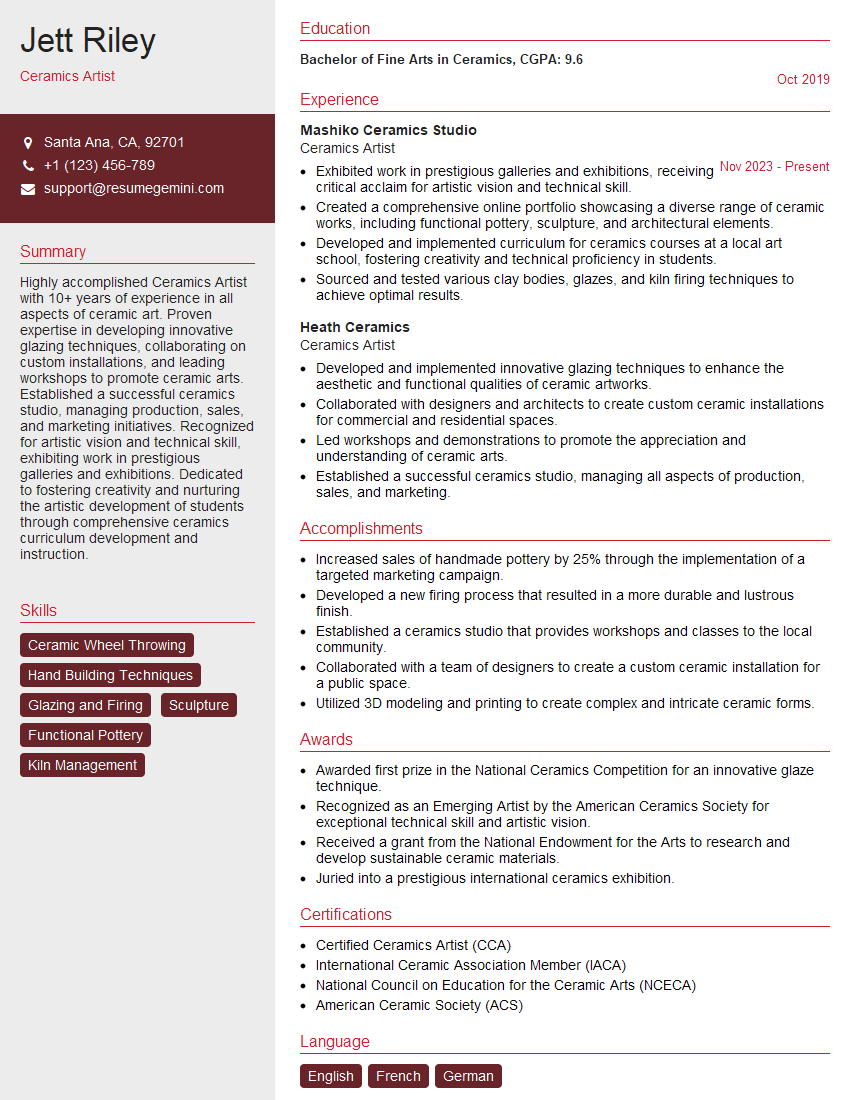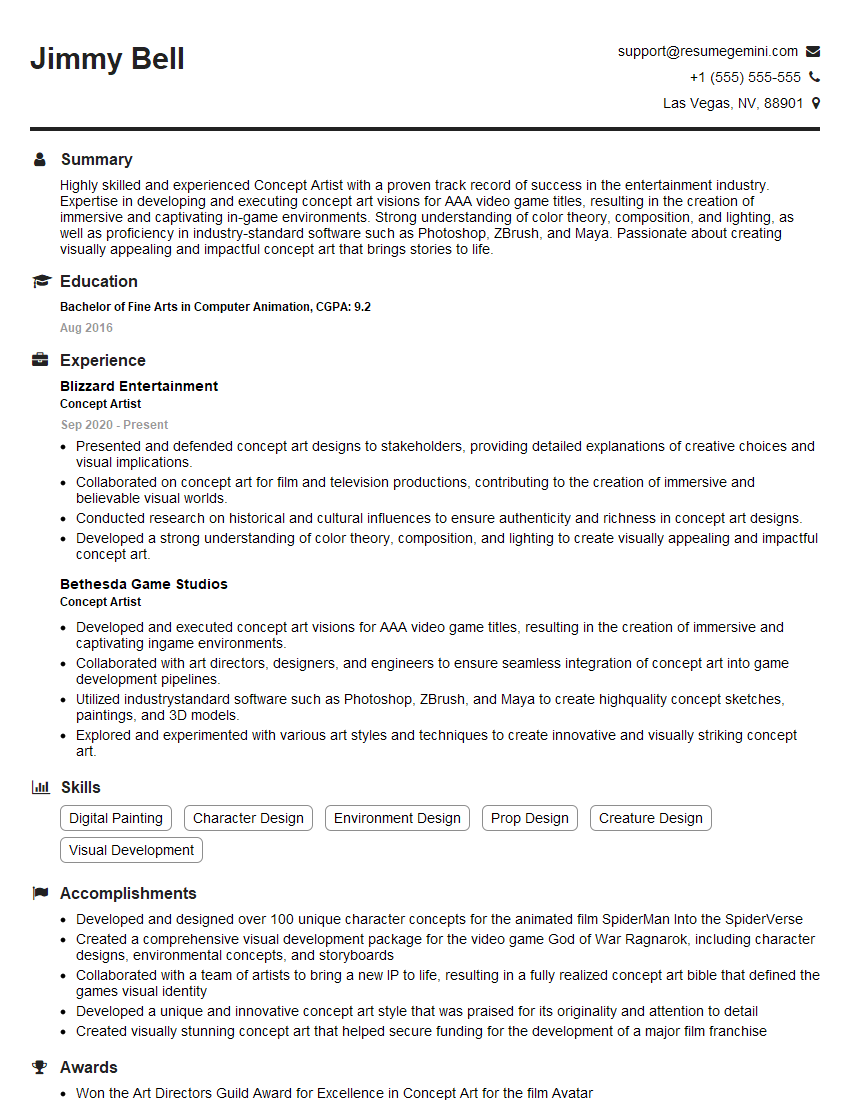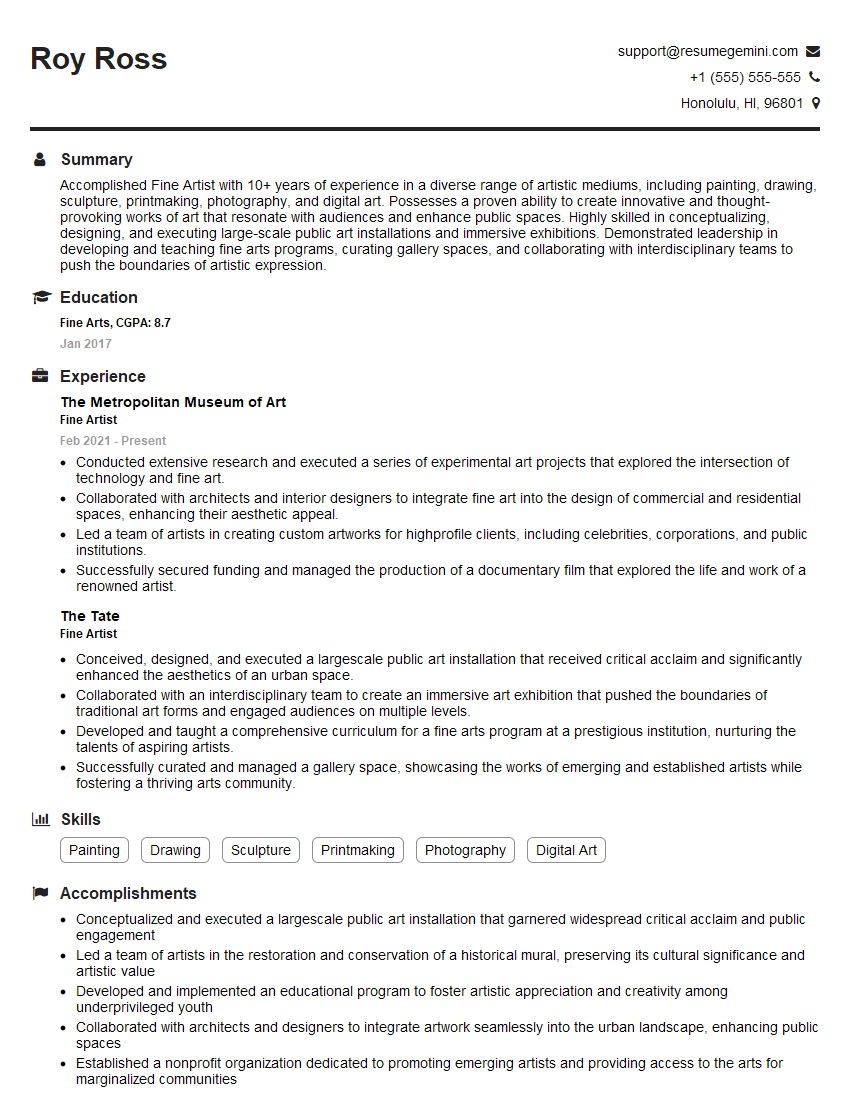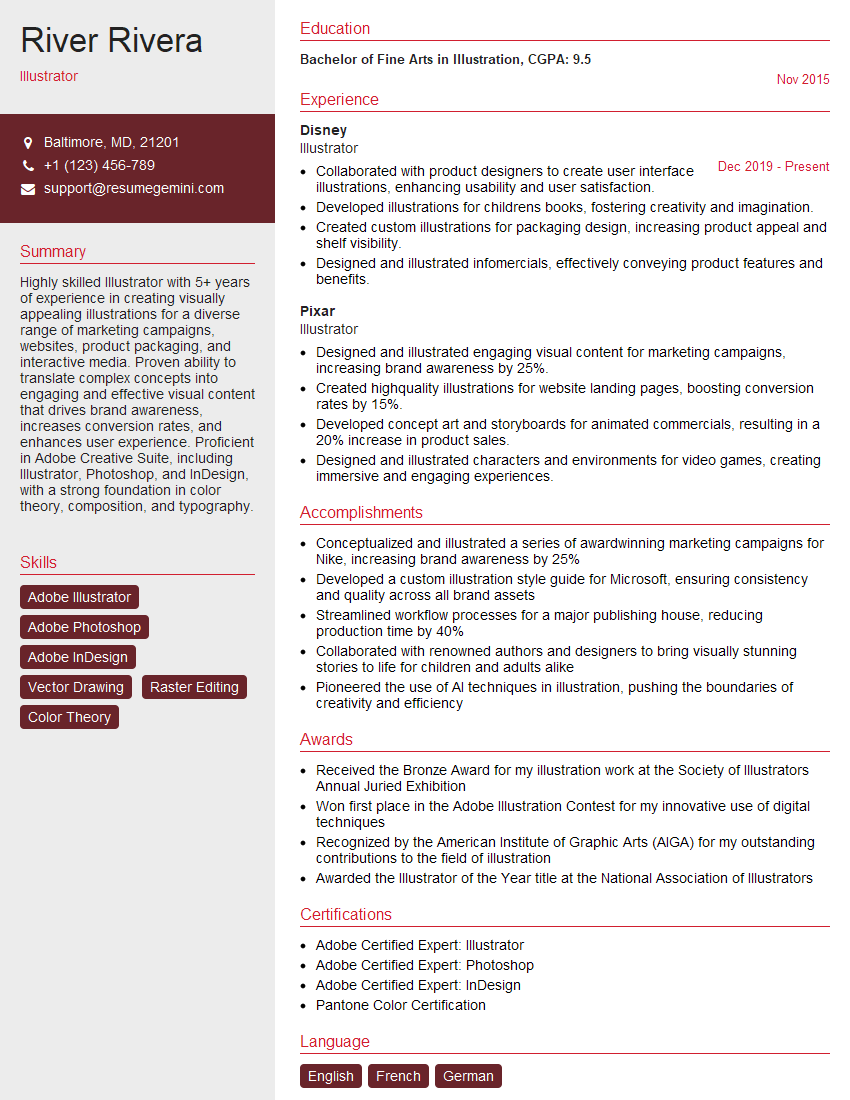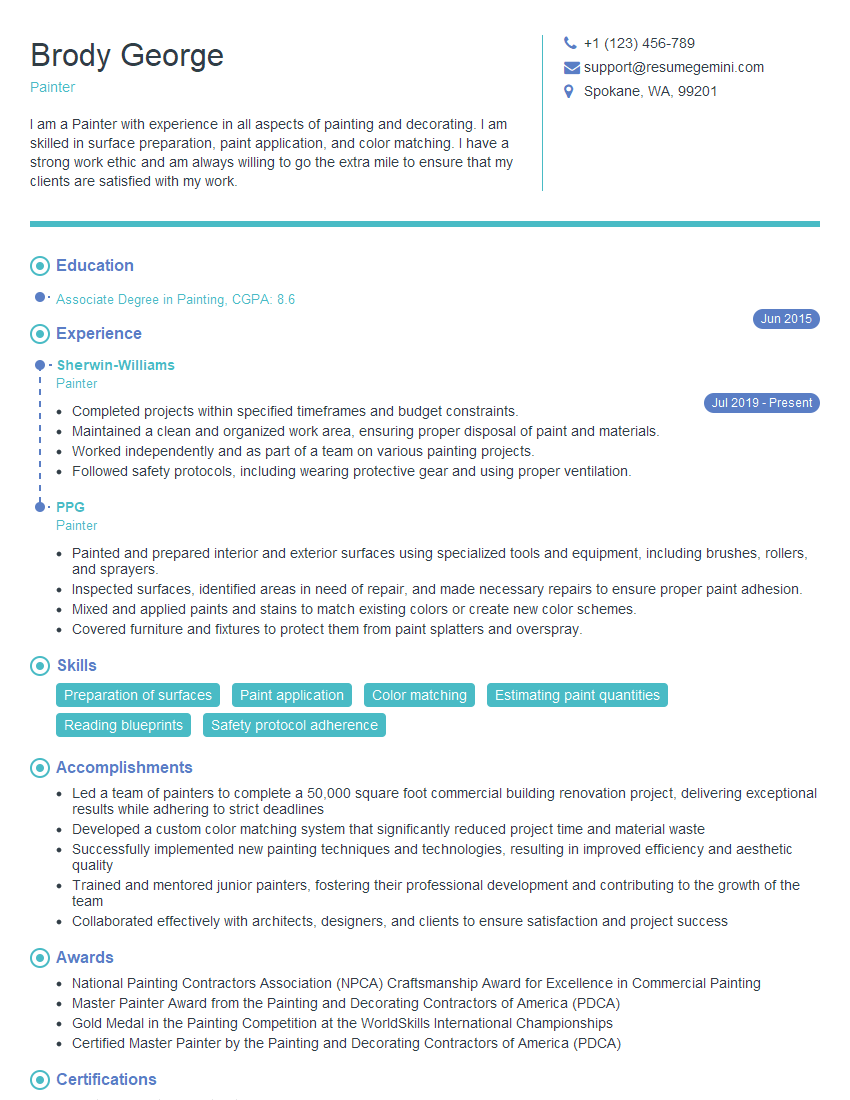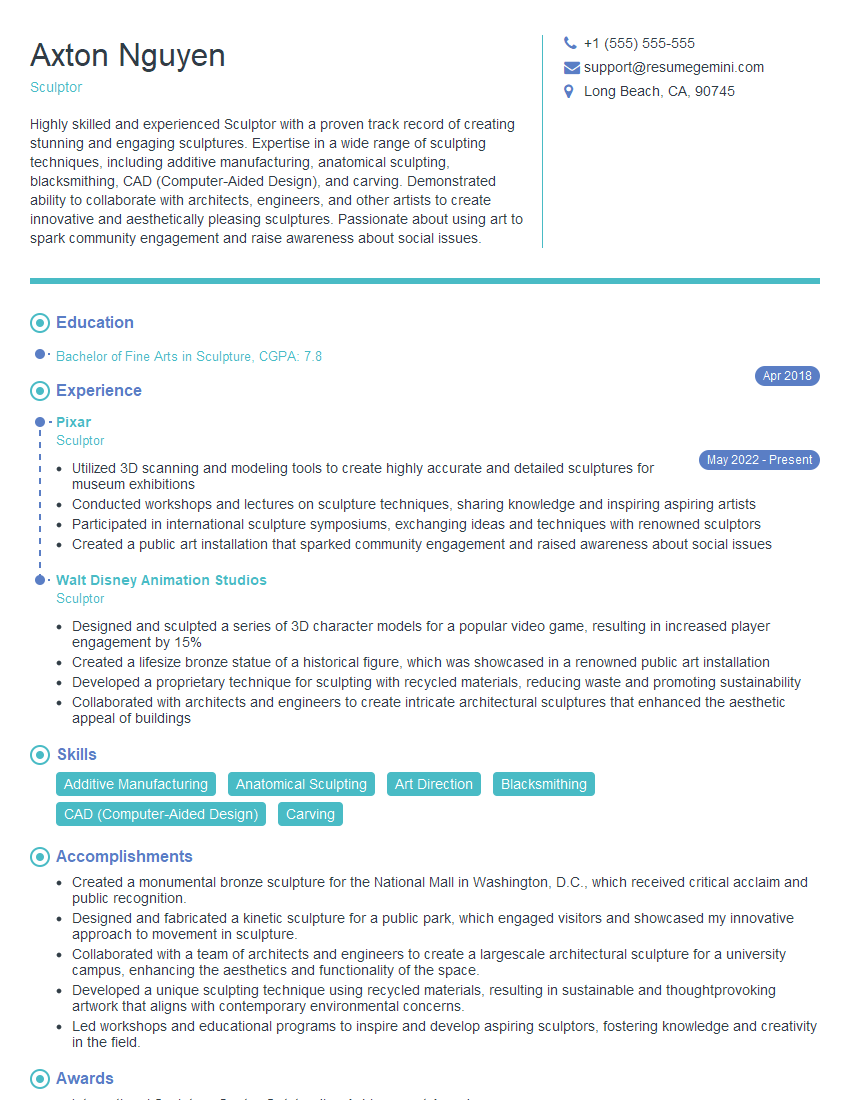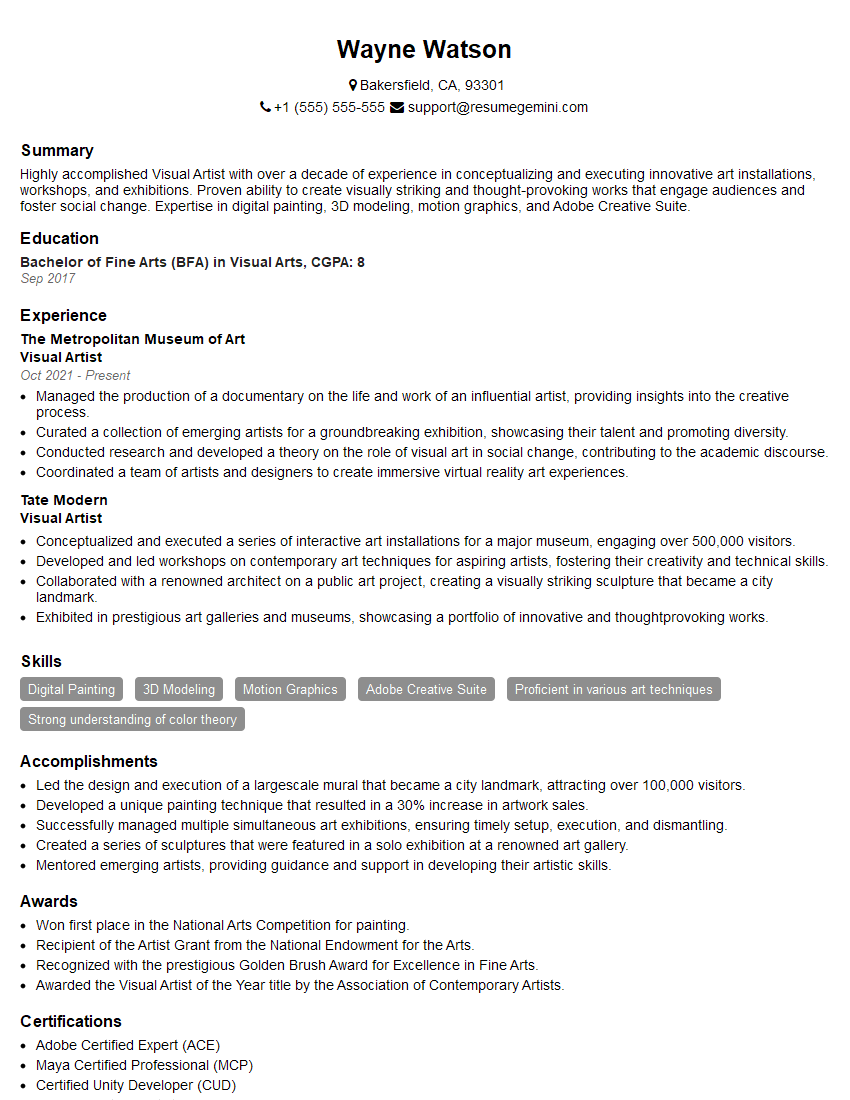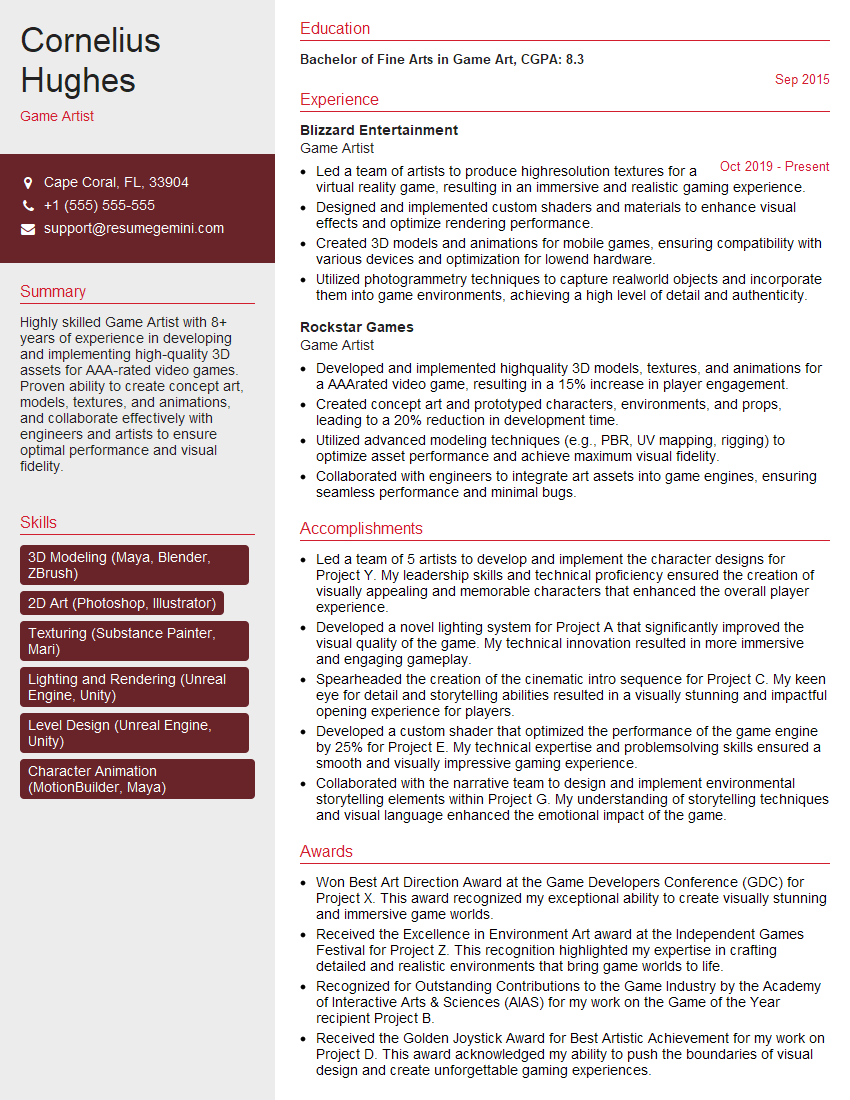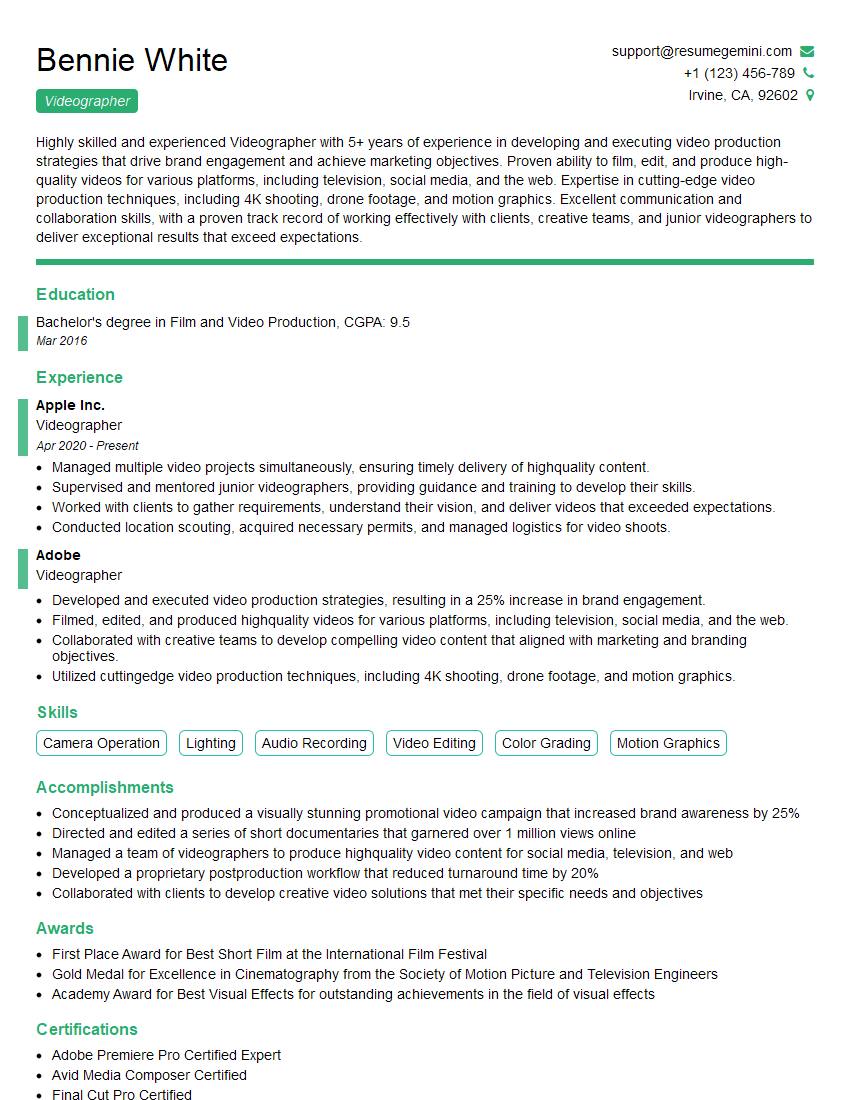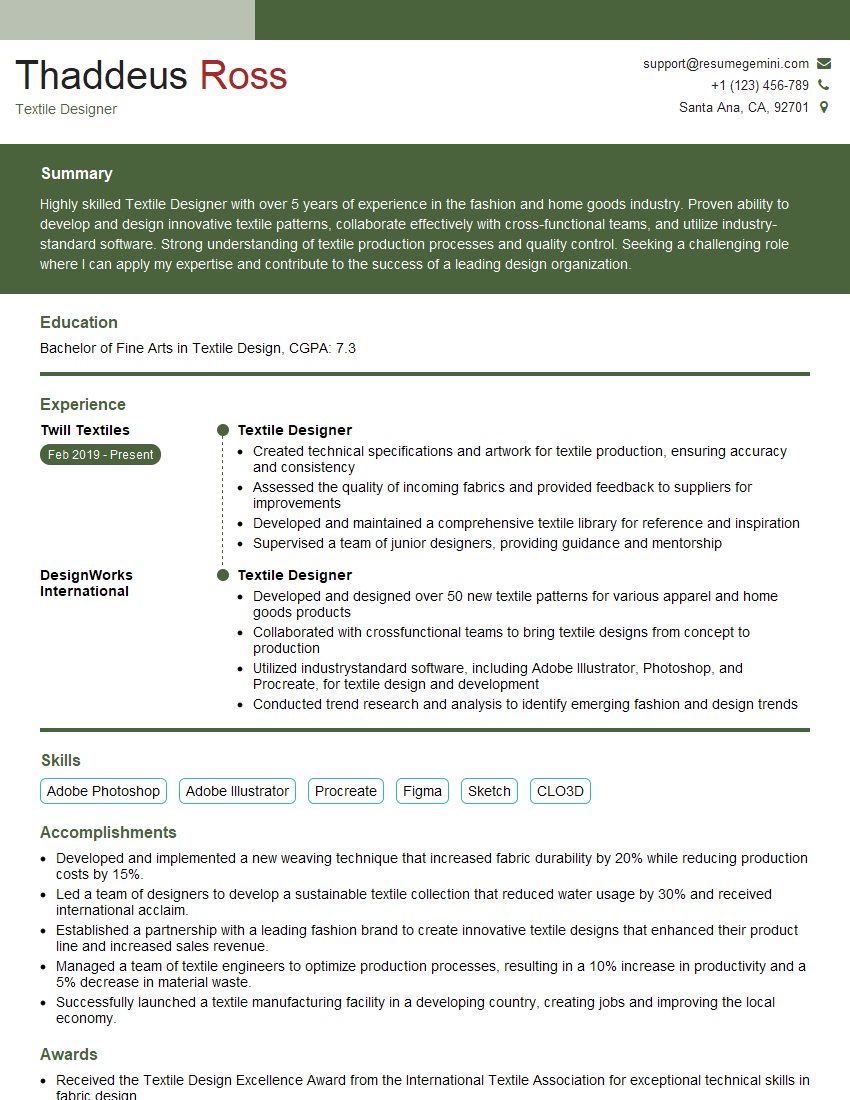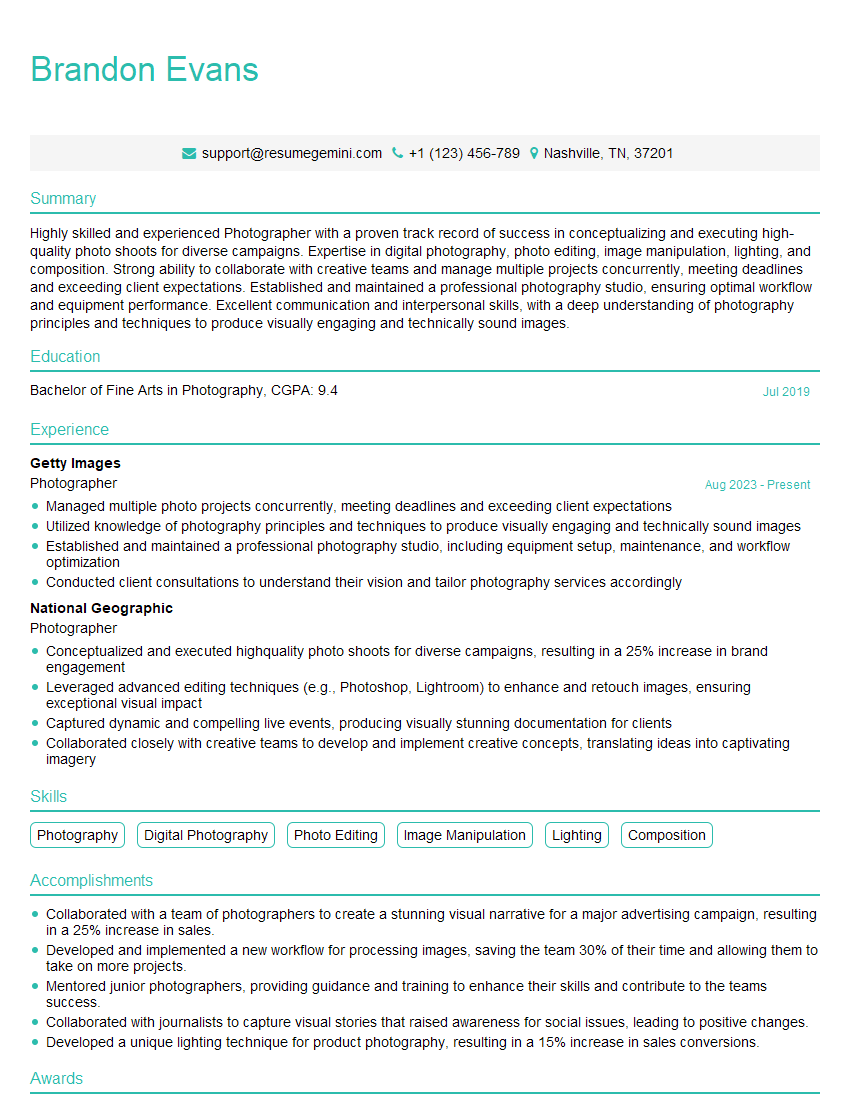Interviews are opportunities to demonstrate your expertise, and this guide is here to help you shine. Explore the essential Proficient in using various artistic media interview questions that employers frequently ask, paired with strategies for crafting responses that set you apart from the competition.
Questions Asked in Proficient in using various artistic media Interview
Q 1. Describe your experience with different artistic media (e.g., painting, digital sculpting, photography).
My artistic journey has encompassed a wide range of media. I’m highly proficient in traditional painting techniques, using oils, acrylics, and watercolors to create both realistic and abstract pieces. I’ve also extensively explored digital sculpting, primarily using ZBrush, where I’ve crafted intricate characters and environments for games and animations. Photography is another significant area of my expertise; I’m adept at capturing evocative imagery, from landscape photography to detailed product shots, and skilled in post-processing using Adobe Lightroom and Photoshop.
For instance, a recent oil painting project involved creating a hyperrealistic portrait, while a current digital sculpting project focuses on creating a detailed fantasy creature model for a video game. In photography, I recently completed a series focusing on architectural details in urban environments, highlighting texture and light interplay.
Q 2. Explain your process for selecting the appropriate artistic media for a given project.
Choosing the right medium depends heavily on the project’s goals and constraints. I consider several factors. Firstly, the desired aesthetic: Does the project require the tactile texture of oil paint, the vibrant immediacy of watercolor, or the precise detail and flexibility of digital sculpting? Secondly, the project’s scale and budget are crucial. A large-scale mural might call for acrylics for their durability and quick drying time, while a highly detailed illustration might be best rendered digitally for ease of revision. Finally, the timeline plays a significant role. Digital media often allow for quicker iterations and revisions than traditional methods.
For example, a client wanting a quick turnaround on a logo design might benefit from digital vector art, while a fine art print might necessitate the richness and depth of oil painting. I always engage in thorough discussions with clients to understand their vision and identify the most suitable medium to bring that vision to life.
Q 3. How do you adapt your artistic style to meet the specific needs of a client or project?
Adaptability is key. I strive to understand a client’s style preferences and project requirements before beginning any work. This might involve researching their previous work, discussing their vision in detail, and providing initial sketches or mock-ups to ensure alignment. I’m comfortable shifting between realistic, impressionistic, abstract, and even stylized approaches depending on the project’s needs. My goal isn’t just to impose my style but to collaborate with the client to create something that perfectly reflects their vision and brand, or the overall aesthetic of the project.
For instance, I recently worked on a project requiring a more minimalist, geometric style, contrasting with my usual preference for detailed realism. By focusing on clean lines and a limited color palette, I successfully delivered a project that met the client’s brief while still demonstrating my artistic skills in a new context.
Q 4. What software and tools are you proficient in using for creating art?
My software proficiency includes the Adobe Creative Suite (Photoshop, Illustrator, Lightroom), ZBrush for 3D sculpting, Blender for 3D modeling and animation, and Cinema 4D for more advanced 3D projects. I also have experience with various vector graphics editors and image editing software. In terms of hardware, I’m comfortable working with both traditional art supplies and specialized digital art tools such as graphics tablets (Wacom Cintiq), 3D printers, and high-resolution cameras.
Q 5. Describe a time you had to overcome a technical challenge while working with artistic media.
During a recent digital sculpting project, I encountered significant issues with mesh topology – essentially, the underlying structure of the 3D model. A complex character design I was creating developed severe distortions and inconsistencies when I tried to apply certain modifications. To solve this, I had to spend several days meticulously retopologizing the mesh, which involves rebuilding the model’s underlying structure. This involved using ZBrush’s sculpting tools to smooth out problematic areas and applying ZRemesher, a powerful automated tool, to create a cleaner and more consistent mesh. This wasn’t just about technical skill; it required patience, problem-solving, and a deep understanding of 3D modeling principles.
Q 6. How do you manage your time and prioritize tasks when working on multiple artistic projects?
Managing multiple projects effectively requires a robust system. I utilize project management software to track deadlines, prioritize tasks, and allocate time effectively. I break down large projects into smaller, manageable tasks, assigning each a specific deadline. I also dedicate specific time blocks each day to focus on individual projects, minimizing distractions. This allows for a more focused and productive workflow, while preventing burnout from juggling multiple demands.
The key is to establish realistic timelines, communicate clearly with clients about progress, and remain flexible when unforeseen challenges arise. Prioritization is done by considering deadlines, project complexity, and client urgency.
Q 7. Explain your understanding of color theory and its application in your work.
Color theory is fundamental to my artistic process. My understanding encompasses the color wheel, color harmonies (complementary, analogous, triadic, etc.), and the principles of hue, saturation, and value. I use color to create mood, evoke emotion, and guide the viewer’s eye through a composition. I consider the psychological impact of colors – for instance, warm colors like reds and oranges can evoke energy and excitement, while cool colors like blues and greens can convey calmness and serenity.
In practice, I might use complementary colors (e.g., blue and orange) to create vibrant contrast in a painting, or analogous colors (e.g., blues and greens) to create a sense of harmony and unity. Value (lightness and darkness) is equally crucial for establishing depth and form. Understanding these principles allows me to make conscious decisions about color choices that enhance the overall impact and effectiveness of my artwork.
Q 8. Describe your approach to composition and layout in your artistic creations.
My approach to composition and layout is deeply rooted in understanding the principles of design, specifically balance, emphasis, movement, and unity. I rarely begin with a preconceived notion of the final piece; instead, I let the medium and my initial creative impulse guide me.
For example, if I’m working with oil paints on canvas, I might start with a loose underpainting to establish value and form, allowing the composition to organically evolve as I work. I might use the rule of thirds, placing key elements off-center to create visual interest. Or, I might opt for a more symmetrical, balanced approach for a sense of calmness and harmony. This choice depends entirely on the intended mood and message of the artwork.
In digital mediums like Photoshop, I utilize the layer system extensively to experiment with different compositions without damaging the underlying image. I might create several thumbnail sketches digitally before committing to a final composition on a larger canvas, allowing for flexibility and refinement.
Ultimately, my goal is to create a composition that is both visually engaging and effectively communicates the intended story or emotion. This involves conscious decisions about negative space, line, shape, color, and texture – all working together in harmony to create a compelling visual experience.
Q 9. How do you ensure the accuracy and consistency of your work across different media?
Maintaining accuracy and consistency across different media requires a thorough understanding of each medium’s unique properties and limitations. I approach this through careful planning and meticulous execution.
For instance, if I’m translating a sketch into a digital painting, I ensure accurate color matching by using color pickers and referencing the original sketch frequently. I also employ techniques like creating custom brushes in digital software to replicate the textures and strokes I achieve with traditional media, such as charcoal or watercolor. When working across multiple mediums, I use a well-defined process that establishes reference points, size ratios, and color schemes. For example, I might create a detailed technical drawing or digital mockup before beginning the more involved work with a physical medium.
Consistency is also maintained through regular self-assessment and refinement. I meticulously review my work at each stage, comparing my progress against initial designs and making adjustments as necessary. This iterative process ensures that the final outcome aligns with my original vision and remains cohesive across different stages and mediums.
Q 10. How do you handle constructive criticism and feedback on your artwork?
Constructive criticism is invaluable to my artistic growth. I actively seek out feedback, not as a measure of personal validation but as a tool for improvement. My approach involves thoughtful consideration of the feedback, separating subjective opinions from objective observations.
I approach critical feedback by first acknowledging the source’s perspective, even if I don’t immediately agree with it. I then analyze the critique; asking myself: Does this critique highlight a technical flaw (e.g., inconsistent line weight, unbalanced composition) or a conceptual weakness (e.g., unclear narrative, lack of emotional impact)? This analysis helps determine how to effectively address the feedback. Sometimes, I might revisit the piece and incorporate the suggestions directly, whilst other times, it informs future projects. Sometimes, the feedback clarifies a conceptual element I wasn’t completely aware of.
Ultimately, I aim to use feedback to refine my skills and expand my artistic vision. I believe that even negative comments can be beneficial if approached with an open mind and a willingness to learn.
Q 11. Describe your experience with different artistic styles and movements.
My artistic journey has involved exploration across various styles and movements, from the realism of classical painting to the abstraction of modern art. Early influences included the Impressionists’ focus on light and color, which I still incorporate into my work through vibrant palettes and loose brushstrokes. I’ve also studied the works of the Expressionists, appreciating their ability to convey raw emotion through distorted forms and bold colors.
More recently, I’ve been drawn to contemporary digital art and its boundless possibilities. This has involved learning new software and techniques and pushing the boundaries of my traditional skills into a new realm. I see this exploration as ongoing— a continuous learning process where I constantly draw inspiration from various sources and styles, seamlessly integrating them into my unique approach.
Each style provides invaluable lessons. For example, studying Renaissance techniques improved my understanding of perspective and anatomy, while exploring abstract expressionism freed me from the constraints of strict realism, enhancing my creativity and expression. This blend of influences makes my work uniquely mine.
Q 12. What are your strengths and weaknesses as an artist?
My strengths lie in my technical proficiency across various media, my ability to effectively communicate emotions and narratives through my work, and my persistent drive for self-improvement. I’m adept at combining diverse techniques and styles to create unique and compelling pieces. I am also a strong conceptual thinker, always aiming for deeper meaning within my art.
However, I also acknowledge my weaknesses. Sometimes, my perfectionism can hinder my progress, causing me to overwork pieces or become overly critical of my work. I’m also continually striving to improve my efficiency in project management and marketing my work to broader audiences.
I actively address my weaknesses through deliberate practice and seeking external feedback. For instance, I have begun using time-management techniques to better allocate my time between creative tasks and administrative duties. I’m also working on building my professional network and exploring various avenues to showcase and sell my art.
Q 13. How do you stay current with new trends and technologies in the field of artistic media?
Staying current involves a multi-pronged approach. I regularly attend workshops and conferences, both in-person and online, to learn about new technologies and techniques. I actively engage with online communities of artists, participating in forums and discussions where innovative ideas and new developments are shared.
I also subscribe to art magazines, follow influential artists on social media, and explore new software and hardware regularly. For example, I recently invested in a new graphics tablet and have been experimenting with AI art generators, exploring how to seamlessly integrate these tools into my creative process.
This continuous learning is essential to adapt to the ever-evolving landscape of artistic media and ensures my skills remain sharp and my creative vision is continually refreshed.
Q 14. Describe your approach to copyright and intellectual property in your work.
Copyright and intellectual property are of paramount importance to me. I understand that my artwork is my intellectual property, and I take steps to protect it. I meticulously document my creative process, retaining sketches, digital files, and progress photos to establish proof of authorship. For physical artwork, I often photograph and digitally record the creation process and date the finished pieces.
For digital works, I utilize watermarks and embed metadata containing copyright information. I also register my copyrights with the appropriate organizations whenever feasible. When licensing my work, I ensure that contracts clearly define the terms of use and protect my rights. I’m always mindful of obtaining the necessary permissions when using copyrighted materials from other sources in my artwork, avoiding any potential infringement.
This cautious approach ensures that my creative efforts are protected and that my intellectual property rights are upheld. I believe it’s crucial for all artists to understand and actively manage their copyright to safeguard their creative work.
Q 15. How do you manage your creative process and overcome creative blocks?
My creative process is a blend of structured planning and spontaneous exploration. I begin with thorough research and brainstorming, often mind-mapping ideas to identify core concepts and potential directions. This helps avoid aimless wandering. For example, if I’m commissioned to create a mural depicting the history of a city, I’d start by researching its key historical events, architectural styles, and cultural icons. This research phase is crucial in establishing a solid foundation.
Creative blocks, however, are inevitable. My strategy involves shifting gears. If I’m stuck on a painting, I might switch to sculpting or sketching to refresh my perspective. I also find inspiration in unexpected places – visiting museums, listening to music, or even taking a walk in nature. Sometimes, simply stepping away from the project for a while and returning with fresh eyes is all it takes. I also actively cultivate a habit of regular creative practice, even if it’s just a quick sketch, to maintain a flow of ideas.
- Structured Planning: Research, brainstorming, mind-mapping.
- Spontaneous Exploration: Experimentation with different mediums, seeking inspiration in diverse sources.
- Overcoming Blocks: Switching mediums, taking breaks, seeking external inspiration.
Career Expert Tips:
- Ace those interviews! Prepare effectively by reviewing the Top 50 Most Common Interview Questions on ResumeGemini.
- Navigate your job search with confidence! Explore a wide range of Career Tips on ResumeGemini. Learn about common challenges and recommendations to overcome them.
- Craft the perfect resume! Master the Art of Resume Writing with ResumeGemini’s guide. Showcase your unique qualifications and achievements effectively.
- Don’t miss out on holiday savings! Build your dream resume with ResumeGemini’s ATS optimized templates.
Q 16. Explain your understanding of visual communication and its importance in your work.
Visual communication is the art of conveying information or ideas using visual elements like images, colors, typography, and layout. It’s the cornerstone of my work because it transcends language barriers and directly engages the viewer’s emotions and understanding. Think of a powerful photograph documenting a social issue – it speaks volumes without needing extensive text. In my work, I carefully consider every visual element to ensure that the message is clear, engaging, and memorable.
For instance, in designing a logo, the choice of font, color palette, and imagery all contribute to the brand’s overall identity and communicate its values. A clean, modern font might suggest innovation, while a rustic, handwritten font might convey tradition. Similarly, vibrant colors can evoke energy and excitement, while muted tones can communicate sophistication and calmness. Understanding these principles is crucial in effectively communicating the intended message.
Q 17. Describe your experience working collaboratively with other artists or designers.
Collaboration is an essential part of my creative process. I’ve had the opportunity to work with various designers, photographers, and writers on diverse projects. One recent example involved designing a series of illustrations for a children’s book. I collaborated closely with the author to ensure that my illustrations accurately reflected the story’s narrative and characters. We exchanged feedback throughout the process, refining the visuals to ensure a cohesive and engaging experience for young readers. This involved regular meetings, sharing sketches and drafts, and actively listening to each other’s perspectives.
Effective collaboration requires open communication, mutual respect, and a shared understanding of the project’s goals. It’s about combining individual strengths to achieve a result that’s greater than the sum of its parts. Active listening, clear communication, and a willingness to compromise are crucial for success in collaborative projects.
Q 18. How do you handle deadlines and meet project requirements?
Managing deadlines effectively involves meticulous planning and prioritization. I begin by breaking down large projects into smaller, manageable tasks, creating a detailed timeline that outlines key milestones and deadlines for each stage. This approach allows for better tracking of progress and allows me to identify potential roadblocks early on. For example, if I’m working on a large-scale mural project, I would create a schedule that includes initial design, material procurement, site preparation, painting phases, and final touches. This granular approach helps ensure that I stay on track and meet the overall deadline.
Furthermore, I utilize project management tools like task lists and digital calendars to stay organized and track my progress. Open communication with clients is key to managing expectations and addressing any potential delays proactively.
Q 19. What is your experience with client communication and project management?
Client communication and project management are intertwined and crucial for project success. I maintain open and transparent communication throughout the entire process, starting with initial consultations to understand the client’s vision and needs. I use a variety of communication channels, including email, phone calls, and video conferencing, to ensure effective exchange of information. I always provide regular updates on progress and actively solicit feedback from clients. This proactive approach ensures that the final product aligns with their expectations.
For project management, I employ a structured approach, creating a detailed proposal that outlines the scope of work, timeline, budget, and payment schedule. This document serves as a roadmap for the entire project, ensuring both client and myself are on the same page. Regular check-ins ensure that the project progresses according to plan, and allows for addressing any arising issues quickly and efficiently.
Q 20. Explain your approach to presenting your artwork to clients or potential employers.
Presenting my artwork involves a strategic approach that considers the audience and the context. For clients, I prepare a well-structured presentation showcasing my work’s conceptual development, the creative process, and the final product. This might involve a portfolio of images, a detailed explanation of design choices, and mockups or prototypes (where applicable). I also tailor my presentation to the client’s specific needs and preferences, emphasizing aspects most relevant to their project. For potential employers, I’d showcase a more comprehensive portfolio highlighting the range of my skills and artistic styles, often with accompanying statements explaining my approach to design problems.
Regardless of the audience, I always aim to deliver a professional and engaging presentation that clearly demonstrates my creative vision and technical abilities. A strong narrative, linking the creative process to the final product, is important to showcase the thought process and reasoning behind the design choices.
Q 21. How do you approach the creation of a concept or initial sketch?
Creating a concept or initial sketch begins with thorough understanding of the project’s requirements and objectives. I usually start by conducting research, brainstorming, and sketching numerous ideas to explore different possibilities. I might use mood boards to collect visual inspiration and establish a theme. Then I move on to developing rough sketches, focusing on composition, proportion, and the overall feel of the piece. These initial sketches are not meant to be perfect; they’re a means of experimenting and exploring various avenues before refining a chosen concept. I often test different approaches and mediums during this initial phase.
For example, when designing a character for a game, I might start by sketching various body shapes, facial expressions, and clothing styles before selecting the most appealing options. This iterative process allows me to experiment and refine my ideas, leading to a strong and well-defined concept that effectively communicates the desired message or aesthetic.
Q 22. What is your process for refining and perfecting your artwork?
Refining artwork is an iterative process, much like sculpting. It involves a series of critical evaluations and adjustments, moving from a general concept to a highly detailed and polished final piece. My process typically involves several stages:
- Initial Creation: This is where the initial idea takes shape. I might start with sketches, digital painting, or even a quick 3D model, depending on the medium.
- Critical Evaluation: I step back and critically assess the piece. I ask myself: Does it communicate the intended message? Are the proportions correct? Is the composition balanced? I often use reference images and seek feedback from trusted colleagues.
- Refinement: Based on the evaluation, I begin refining the artwork. This might involve adjusting colors, refining shapes, adding details, or even completely reworking sections. I use various tools, from digital brushes and sculpting software to traditional mediums like fine-tipped pens and erasers.
- Polishing: The final stage focuses on perfecting the details. This could involve subtle color adjustments, adding subtle textures, enhancing contrast, or ensuring smooth transitions. It’s about creating a visually pleasing and technically flawless piece.
For example, while working on a digital painting of a landscape, I might initially focus on getting the overall composition right. Then, I’d move on to refining the individual elements like trees, clouds, and water, before finally polishing the piece by adjusting the lighting and color balance to create a more realistic and atmospheric effect. This whole process often involves many layers and revisions, each building upon the previous one.
Q 23. Describe your experience with different printing techniques and processes.
My experience with printing techniques spans various methods, each with its unique advantages and limitations. I’m proficient in:
- Giclée Printing: This high-quality inkjet printing process utilizes archival inks, making it ideal for fine art reproduction. It offers excellent color accuracy and detail, and I frequently use it for creating limited-edition prints of my original artwork.
- Screen Printing: A versatile technique for producing multiple prints, screen printing allows for vibrant colors and bold graphics. I’ve used it for both fine art and design projects, particularly where a handmade, textured effect is desired.
- Offset Lithography: Best suited for large-scale printing, offset lithography is efficient for mass production and offers sharp, consistent results. I typically use this method for projects requiring high print volumes, such as posters or book illustrations.
- Digital Printing: A broadly encompassing term including various methods such as inkjet and laser printing. It’s incredibly versatile and convenient, often used for creating proofs, smaller runs, or quick prototypes. Understanding the capabilities and limitations of each printer is key to achieving optimal results.
Choosing the right printing technique depends heavily on the project’s requirements—the number of prints needed, the desired aesthetic, and the budget. For instance, for a fine art print of a single piece, giclée printing is ideal, whereas for a mass-produced poster, offset lithography would be more efficient.
Q 24. Explain your understanding of different file formats and their applications in artistic media.
Understanding file formats is critical for any artist working in digital media. Each format has specific properties that influence how an image is stored and displayed. Some key formats and their applications include:
- JPEG (JPG): A widely used format for photographs and images intended for web display. It offers good compression, resulting in smaller file sizes, but can cause some loss of image quality with repeated saving and editing.
- PNG: A lossless format ideal for images with sharp lines, text, and graphics. It’s commonly used for logos, illustrations, and images requiring high detail and transparency.
- TIFF: A high-quality, lossless format often used for professional printing and archiving. TIFF files are larger than JPEGs but retain all image data, ensuring perfect reproduction.
- PSD (Photoshop): A proprietary format used by Adobe Photoshop. It’s capable of storing layers, masks, and other editing information, making it essential for collaborative work and preserving editing history. It’s not suitable for web display without conversion.
- SVG (Scalable Vector Graphics): A vector-based format ideal for logos, illustrations, and graphics that need to be resized without losing quality. Unlike raster formats (like JPEG and PNG), SVGs are resolution-independent.
Choosing the right format depends on the intended use. For web use, I usually opt for optimized JPEGs or PNGs, while for printing, TIFF is preferred to ensure the highest quality reproduction.
Q 25. How do you ensure the quality and resolution of your digital artwork?
Maintaining high quality and resolution in digital artwork requires careful planning and execution from the initial stages of creation. Key strategies include:
- High Resolution Source Files: Start with the highest possible resolution. The larger the file, the more detail it can retain when scaled down.
- Color Management: Use a calibrated monitor and profile your color space to ensure consistent color rendering across different devices. Using a color profile like sRGB for web and Adobe RGB for print is standard practice.
- Appropriate File Formats: Choosing the right format is vital. For print, TIFF or high-resolution PNG is preferred. For web, a well-optimized JPEG can work well, balancing file size and quality.
- Non-Destructive Editing: Using layers and adjustment layers in software like Photoshop allows for non-destructive editing, preserving the original image data and preventing quality loss.
- Regular File Backups: Regularly backing up your files to an external hard drive or cloud storage is crucial to protect your work from data loss.
For instance, if I’m creating artwork for a large-format print, I’d ensure my source file is at least 300 DPI (dots per inch). This would allow for high-quality reproduction without pixelation or loss of detail.
Q 26. How do you maintain the integrity of your original artwork during reproduction?
Maintaining the integrity of original artwork during reproduction requires careful consideration of several factors. The goal is to create accurate, high-quality reproductions without damaging the original piece:
- High-Quality Scanning or Photography: If creating digital reproductions from physical artwork, it’s crucial to use a high-resolution scanner or camera with appropriate lighting to capture all the details and colors accurately.
- Non-Destructive Reproduction Methods: Methods like giclée printing offer high-quality reproduction without direct contact with the original, minimizing the risk of damage.
- Archival Materials: Use archival-quality materials for reproduction and storage. This ensures the longevity of both the original and the reproduction.
- Proper Handling: Always handle original artwork with care, wearing gloves to avoid smudging or damaging the surface. Store it in a controlled environment to prevent degradation.
- Professional Reproduction Services: For valuable or delicate artwork, consider using professional reproduction services. They have the expertise and equipment to create high-quality reproductions while protecting the original.
For example, when reproducing a delicate watercolor painting, I would use a high-resolution scanner with a transparency unit and carefully control the lighting to avoid glare and color distortion. Then, I would use a giclée printer with archival inks to create the reproduction.
Q 27. Describe your experience with creating art for different platforms (e.g., web, print, animation)
My experience spans various platforms, requiring adaptation of techniques and style to suit each medium’s specific requirements:
- Web: Creating art for the web often involves optimizing images for fast loading times. This means using smaller file sizes (often achieved through JPEG compression) and ensuring the images are responsive and adapt to different screen sizes. I typically use vector graphics for logos and elements that need scaling.
- Print: Print art requires higher resolution (typically 300 DPI or more) and consideration of the printing process and the paper type. Color profiles are vital to ensure accurate color reproduction.
- Animation: Creating art for animation involves understanding the principles of motion and storytelling. This may include creating character designs, background art, and storyboards, often using software such as Adobe Animate or After Effects. Frame rate, file formats, and color palettes are carefully selected to optimize the animation process.
For example, when designing a website banner, I’d optimize the image for web use, prioritizing smaller file size and responsiveness. In contrast, when illustrating a book, I’d focus on creating high-resolution files suitable for offset printing. For animation, I’d focus on creating consistent character designs that smoothly transition between frames, paying close attention to details such as line weights and color.
Key Topics to Learn for Proficient in using various artistic media Interview
- Understanding Diverse Media: Explore the properties and limitations of various artistic media, including painting (oil, acrylic, watercolor), drawing (pencil, charcoal, ink), sculpting (clay, stone, wood), printmaking (etching, screen printing), digital art (Photoshop, Illustrator), and mixed media techniques. Consider the theoretical underpinnings of each medium’s aesthetic impact.
- Technical Proficiency & Skill Demonstration: Be prepared to discuss your practical skills in handling different tools and materials. Highlight your ability to execute specific techniques effectively. For example, discuss color mixing strategies, perspective drawing, sculpting techniques, digital painting workflows, or printmaking processes. Be ready to articulate your workflow and problem-solving approaches for various artistic challenges.
- Artistic Concepts & Principles: Demonstrate understanding of fundamental artistic concepts such as composition, color theory, perspective, form, texture, and value. Be ready to discuss how these principles inform your creative choices and problem-solving approaches within different media.
- Creative Process & Conceptualization: Be prepared to discuss your creative process, from initial concept development to final execution. Explain your ability to translate ideas into tangible artistic forms and the rationale behind your creative decisions. Highlight your problem-solving skills when encountering unexpected challenges.
- Portfolio & Self-Promotion: Develop a strong portfolio showcasing your work across various media. Practice articulating your artistic vision and the stories behind your creations. Understand how to present your work professionally and effectively communicate your unique artistic voice.
Next Steps
Proficiency in using various artistic media is a highly valuable skill in many creative fields, opening doors to exciting career opportunities. Mastering these skills and effectively communicating your abilities is crucial for career advancement. To increase your chances of landing your dream job, focus on crafting an ATS-friendly resume that highlights your skills and experience in a clear and concise manner. ResumeGemini is a trusted resource that can help you build a professional resume tailored to your specific skills and experience. Examples of resumes tailored to showcasing proficiency in various artistic media are available through ResumeGemini. Take advantage of these resources to create a compelling resume and showcase your artistic talents effectively.
Explore more articles
Users Rating of Our Blogs
Share Your Experience
We value your feedback! Please rate our content and share your thoughts (optional).
What Readers Say About Our Blog
Hello,
We found issues with your domain’s email setup that may be sending your messages to spam or blocking them completely. InboxShield Mini shows you how to fix it in minutes — no tech skills required.
Scan your domain now for details: https://inboxshield-mini.com/
— Adam @ InboxShield Mini
Reply STOP to unsubscribe
Hi, are you owner of interviewgemini.com? What if I told you I could help you find extra time in your schedule, reconnect with leads you didn’t even realize you missed, and bring in more “I want to work with you” conversations, without increasing your ad spend or hiring a full-time employee?
All with a flexible, budget-friendly service that could easily pay for itself. Sounds good?
Would it be nice to jump on a quick 10-minute call so I can show you exactly how we make this work?
Best,
Hapei
Marketing Director
Hey, I know you’re the owner of interviewgemini.com. I’ll be quick.
Fundraising for your business is tough and time-consuming. We make it easier by guaranteeing two private investor meetings each month, for six months. No demos, no pitch events – just direct introductions to active investors matched to your startup.
If youR17;re raising, this could help you build real momentum. Want me to send more info?
Hi, I represent an SEO company that specialises in getting you AI citations and higher rankings on Google. I’d like to offer you a 100% free SEO audit for your website. Would you be interested?
Hi, I represent an SEO company that specialises in getting you AI citations and higher rankings on Google. I’d like to offer you a 100% free SEO audit for your website. Would you be interested?
good


